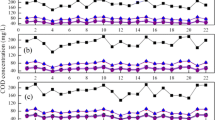Abstract
A recently reported stable and efficient EBPR system at high temperatures around 30 °C has led to characterization of kinetic and stoichiometric parameters of the Activated Sludge Model no. 2d (ASM2d). Firstly, suitable model parameters were selected by identifiability analysis. Next, the model was calibrated and validated. ASM2d was found to represent the processes well at 28 and 32 °C except in polyhyroxyalkanoate (PHA) accumulation of the latter. The values of the kinetic parameters for PHA storage (q PHA), polyphosphate storage (q PP) and growth (μ PAO) of polyphosphate-accumulating organisms (PAOs) at 28 and 32 °C were found to be much higher than those reported by previous studies. Besides, the value of the stoichiometric parameter for the requirement of polyphosphate for PHA storage (Y PO4) was found to decrease as temperature rose from 28 to 32 °C. Values of two other stoichiometric parameters, i.e. the growth yield of heterotrophic organisms (Y H) and PAOs (Y PAO), were high at both temperatures. These calibrated parameters imply that the extremely active PAOs of the study were able to store PHA, store polyphosphate and even utilize PHA for cell growth. Besides, the parameters do not follow the Arrhenius correlation due to the previously reported unique microbial clade at 28 and 32 °C, which actively performs EBPR at high temperatures.




Similar content being viewed by others
References
Cao YS (2011) Biological phosphorus removal activated sludge process in warm climates. IWA Publishing, London
Erdal UG, Erdal ZK, Randall CW (2003) The competition between PAOs (phosphorus accumulating organisms) and GAOs (glycogen accumulating organisms) in EBPR (enhanced biological phosphorus removal) systems at different temperatures and the effects on system performance. Water Sci Technol 47(11):1–8
Panswad T, Doungchai A, Anotai J (2003) Temperature effect on microbial community of enhanced biological phosphorus removal system. Water Res 37:409–415
Whang LM, Park JK (2006) Competition between polyphosphate- and glycogen-accumulating organisms in enhanced biological phosphorus removal systems: effect of temperature and sludge age. Water Environ Res 78:4–11
Ong YH, Chua ASM, Lee BP, Ngoh GC (2013) Long-term performance evaluation of EBPR process in tropical climate: start-up, process stability, and the effect of operational pH and influent C: P ratio. Water Sci Technol 67(2):340–346
Ong YH, Chua ASM, Ngoh GC, Fukushima T, Shoji T (2014) High-temperature EBPR process: the performance, analysis of PAOs and GAOs and the fine-scale population study of Candidatus ‘Accumulibacter phosphatis’. Water Res 64:102–112
Gujer W, Henze M, Mino T, Matsuo T, Wentzel MC, Marais GvR (1995) The Activated Sludge Model No. 2: biological phosphorus removal. Water Sci Technol 31(2):1–11
Henze M, Gujer W, Mino T, Matsuo T, Wentzel MC, Marais GvR, van Loosdrecht MCM (1999) Activated Sludge Model No. 2d, ASM2d. Water Sci Technol 39(1):165–182
Garcia-Usach F, Ferrer J, Bouzas A, Seco A (2006) Calibration and simulation of ASM2d at different temperatures in a phosphorus removal pilot plant. Water Sci Technol 53(12):199–206
Whang LM, Filipe CDM, Park JK (2007) Model-based evaluation of competition between polyphosphate- and glycogen-accumulating organisms. Water Res 41:1312–1324
Lopez-Vazquez CM, Oehmen A, Hooijmans CM, Brdjanovic D, Gijzen HJ, Yuan Z, van Loosdrecht MCM (2009) Modeling the PAO–GAO competition: effects of carbon source, pH and temperature. Water Res 43:450–462
APHA, Awwa, WEF (1998) Standard methods for the examination of water and wastewater, 20th edn. APHA, AWWA, WEF, Washington, DC
Satoh H, Mino T, Matsuo T (1994) Deterioration of enhanced biological phosphorus removal by the determination of microorganism without polyphosphate accumulation. Water Sci Technol 46(1–2):145–154
Pijuan M, Saunders AM, Guisasola A, Baeza JA, Casas C, Blackall LL (2004) Enhanced biological phosphorus removal in a sequencing batch reactor using propionate as the sole carbon source. Biotechnol Bioeng 85(1):56–67
Hauduc H, Rieger L, Takács I, Héduit A, Vanrolleghem PA, Gillot S (2010) A systematic approach for model verification: application on seven published Activated Sludge Models. Water Sci Technol 61(4):825–839
Brun R, Kühni M, Siegrist H, Gujer W, Reichert P (2002) Practical identifiability of ASM2d parameters: systematic selection and tuning of parameter subsets. Water Res 36:4113–4127
Reichert P (1994) AQUASIM: a tool for simulation and data analysis of aquatic systems. Water Sci Technol 30(2):21–30
Liwarska-Bizukojc E, Olejnik D, Biernacki R, Ledakowicz S (2011) Calibration of a complex activated sludge model for the full-scale wastewater treatment plant. Bioprocess Biosyst Eng 34:659–670
Brun R, Reichert P (2001) Practical identifiability analysis of large environmental simulation models. Water Resour Res 37(4):1015–1030
Machado VC, Lafuente J, Baeza JA (2014) Activated sludge model 2d calibration with full-scale WWTP data: comparing model parameter identifiability with influent and operational uncertainty. Bioprocess Biosyst Eng 37:1271–1287
Lopez-Vazquez CM, Hooijmans CM, Brdjanovic D, Gijzen HJ, van Loosdrecht MCM (2009) Temperature effects on glycogen accumulating organisms. Water Res 43:2852–2864
Swinarski M, Makinia J, Stensel HD, Czerwionka K, Drewnowski J (2012) Modeling external carbon addition in biological nutrient removal processes with an extension of the International Water Association Activated Sludge Model. Water Environ Res 84(8):646–655
Brdjanovic D, van Loosdrecht MCM, Hooijmans CM, Alaerts GJ, Heijnen JJ (1998) Influence of temperature on biological phosphorus removal: process and molecular ecological studies. Water Res 32(4):1035–1048
Acknowledgments
The authors thank Professor Takashi Mino and Dr. Hiroyasu Satoh from the University of Tokyo for their useful advice and encouragement. This work is financially supported by the University of Malaya Research Grant (RG152-12AET) and the Postgraduate Research Grant (PG023-2012B).
Author information
Authors and Affiliations
Corresponding author
Rights and permissions
About this article
Cite this article
Liau, K.F., Shoji, T., Ong, Y.H. et al. Kinetic and stoichiometric characterization for efficient enhanced biological phosphorus removal (EBPR) process at high temperatures. Bioprocess Biosyst Eng 38, 729–737 (2015). https://doi.org/10.1007/s00449-014-1313-3
Received:
Accepted:
Published:
Issue Date:
DOI: https://doi.org/10.1007/s00449-014-1313-3




